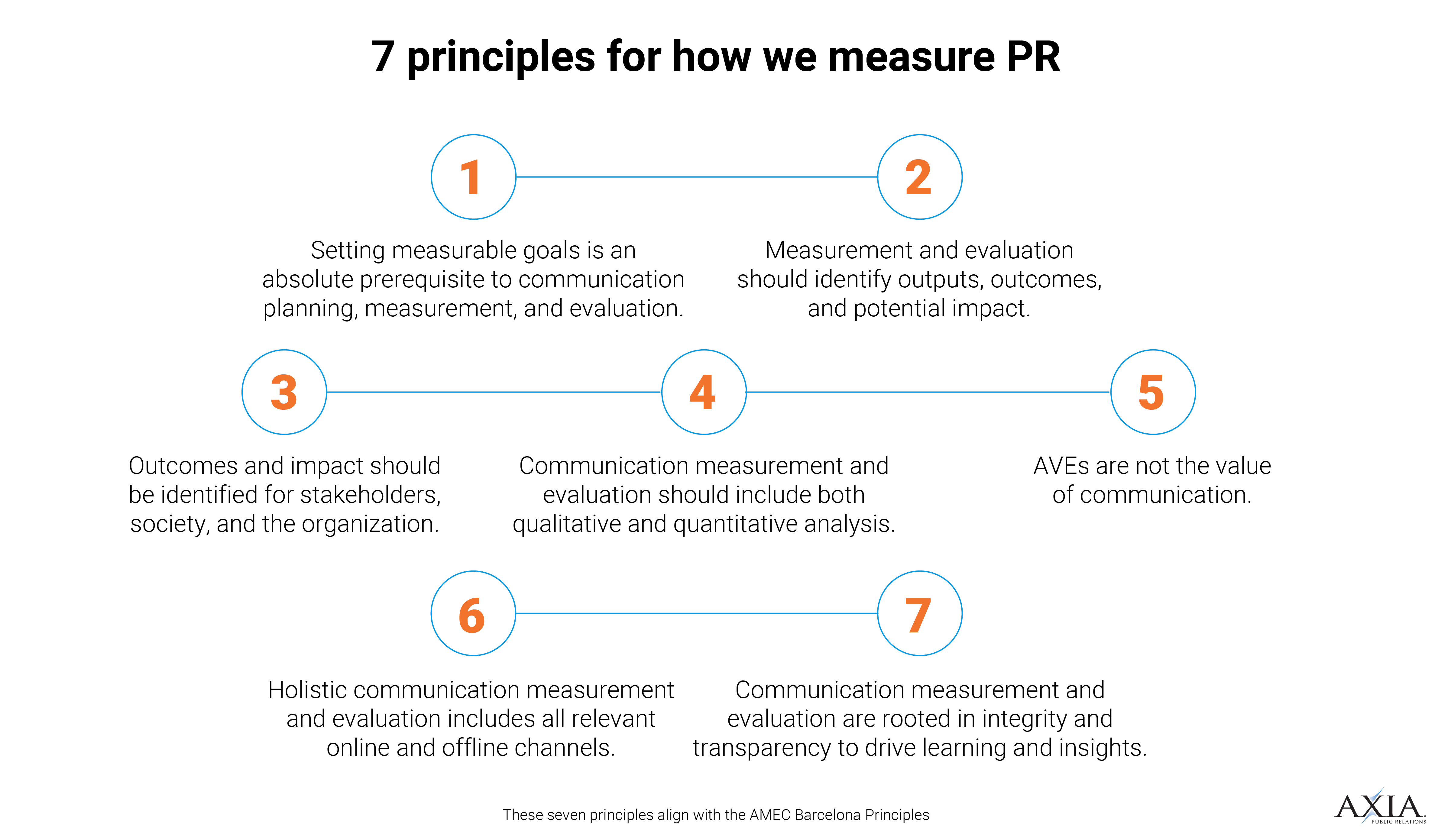![]() At Axia Public Relations, we have seven principles for how we measure PR and a four-level measurement approach that provides the true impact to your organization. This approach includes setting SMART objectives and using communication methods to move your target audiences down the PR measurement funnel to the impacts stage where they’ll take action.
At Axia Public Relations, we have seven principles for how we measure PR and a four-level measurement approach that provides the true impact to your organization. This approach includes setting SMART objectives and using communication methods to move your target audiences down the PR measurement funnel to the impacts stage where they’ll take action.
 Axia’s seven principles are aligned with the AMEC Barcelona Principles
Axia’s seven principles are aligned with the AMEC Barcelona Principles
1. Goal-setting and measurement are vital.
Creating a public relations plan helps direct the overall campaign. Include S.M.A.R.T. objectives that you can measure and track throughout the campaign to understand if your PR efforts are working.
2. Measuring PR's effect on outcomes is more telling than measuring outputs.
Outputs are the messages your target audiences see. Common outputs include news releases, media coverage, social media postings, and website content. Outcomes are the changes in the audience. Common PR outcomes include increasing trust, advocacy, preference, and overall attitude change. Once you release the messaging, measure if and how the audiences change.
3. You can and should measure PR’s effect on business results.
Your company is regularly measuring sales and other KPIs that show the health of the overall organization. It’s important to measure how PR activities affect these business KPIs to show if PR is working or not. For example, monitor your company’s website traffic around earned media coverage to reveal the increase of visitors who may become leads and sales.
4. Media measurement requires quantity and quality.
Earned media coverage is an important channel for your PR campaign. When a third-party speaks highly of your brand, it increases your credibility. To measure your news coverage, include the quality of the coverage. If your CEO’s quote appears first above competitors, that’s favorable to your company. Impressions are a common metric to measure how many potential people saw the media coverage (quantity). However, what if it was negative press? That’s why quality is important to consider too.
5. Advertising value equivalency is not the value of public relations.
Also known as AVEs, these large monetary figures don’t provide the true value of earned media coverage. Consumers don’t weigh a news article and an advertisement the same. People don’t open the paper to read the ads. At Axia PR, we encourage you to consider better metrics for earned media coverage.
6. You can and should measure social media.
Social media is a great channel to reach audiences directly where they’re actively communicating. Measuring vanity metrics such as likes, followers, and engagement is typical; however, it doesn’t provide the full value of your social media efforts.
7. Transparency and replicability are paramount to sound measurement.
In order to measure the value of your public relations efforts, it’s key to have full transparency and understanding of what the numbers mean. Identify any holes in your metrics and provide the full picture of their sources. Be able to replicate your efforts to measure the same numbers at later dates to see increases or decreases.
See also the Power of PR and How do you measure PR?
If your current PR agency doesn’t understand the importance of ROI for your company, it’s time to find a PR partner who uses best practices. Read Axia’s complimentary e-book “How to Fire Your PR Firm” to learn what you should expect from your PR firm and how to have a smooth transition when you decide to move on.
Interested in more details about public relations measurement? We have another blog post about the seven principles for measuring PR.
 Clients love Katie’s energy and enthusiasm. She manages national PR campaigns. Katie has worked with Axia Public Relations since September 2015. Learn more about Katie.
Clients love Katie’s energy and enthusiasm. She manages national PR campaigns. Katie has worked with Axia Public Relations since September 2015. Learn more about Katie.
Topics: public relations, measurement, earned media


Comment on This Article